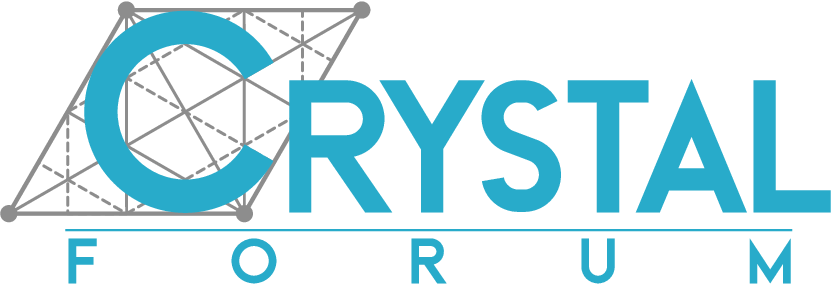Let me just add that we do have a development version of the code for HSE+SOC, which we plan to include in the next release.
Alessandro Erba
Posts
-
Question on HSE06 + SOC Support and MPI Abort in CRYSTAL23 -
malloc during BOLTZTRA (Pproperties)Thanks!
Could you share also the .d12 CRYSTAL input that generated the .f9 file? -
How create band structure in P1 symmetryHi,
Let me just add that of course in P1 there are no special high-symmetry points to guide you in the definition of the path, so you need to be a little creative. For instance, you can start from Gamma (0 0 0) and go to the edge of the FBZ along the b1 reciprocal lattice (1/2 0 0), to then go to (1/2 1/2 0), then to (0 1/2 0) then back to Gamma (0 0 0) and then to the edge along the b3 reciprocal lattice (0 0 1/2). Or something else!

-
extract asymmetric fragmentHi,
Jefferson Maul has managed to generate this .cif file with 4 symmetry operators. As you suggest, there are probably more but this is what he could extract so far.
Beautiful system by the way: looks like a Christmas tree bauble!

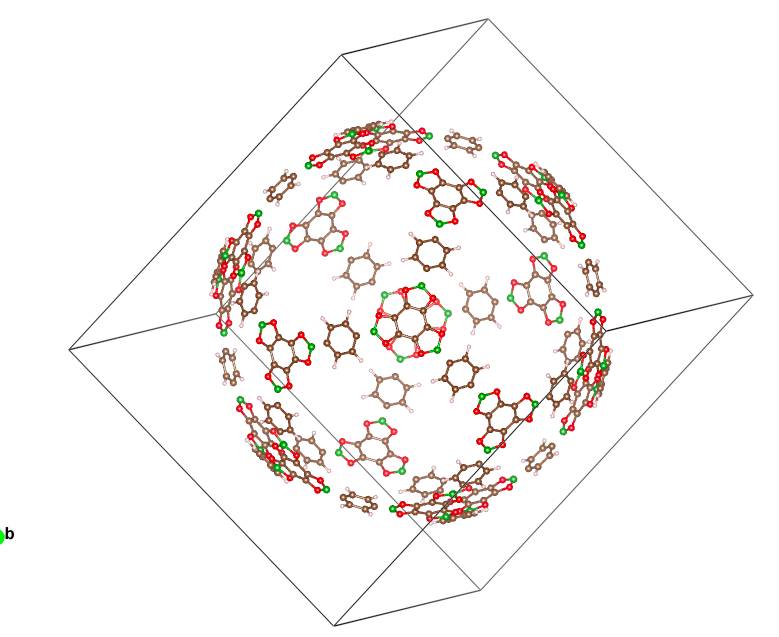
-
SCANMODE io error Read_int_1dHi,
job314 said in SCANMODE io error Read_int_1d:
So it turns out having fort.13 and fort.20 is not optional for restart.
Yes, the lack of these two files was the origin of the I/O error.
job314 said in SCANMODE io error Read_int_1d:
PS. I would also like to ask developers to allow uploading compressed files to this forum
Now also .zip, .tar, .tgz, .tar.gz files can be uploaded.
Cheers,
-
OPTGEOM for RUNCONFSHi,
Before running the actual single-point or geometry optimization calculations on the configurations with RUNCONFS, a list of configurations needs to be generated by use of the CONFRAND option. The list of generated configurations is saved into a file CONFIGURATIONS.DAT that is then read by the next RUNCONFS calculation.
Let us go through this step-by-step. I take your system as an example.
- First, you would setup an input for the CONFRAND calculation. For instance:
Title CRYSTAL 0 0 0 194 3.065 17.656 4 22 0 0 0.5 14 0 0 0.75 22 0.666666 0.333333 0.364919 6 0.333333 0.666666 0.427507 SCELCONF 1 0 0 0 1 0 0 0 1 CONFRAND 1 5 2 ENDHere I am selecting just one crystallographic site for substitution, specified by atom number 5, which is a Ti atom. Given the symmetry of this system, that atom has a multiplicity of 4 (i.e. there are other 3 Ti atoms symmetry-related to it). This can be inspected from here (in bold the selected atoms, in italic its symmetry-equivalents):
N. ATOM EQUIV AT. N. X Y Z 1 1 1 22 TI 0.00000000000E+00 0.00000000000E+00 -5.00000000000E-01 2 1 2 22 TI 0.00000000000E+00 0.00000000000E+00 0.00000000000E+00 3 2 1 14 SI 0.00000000000E+00 0.00000000000E+00 -2.50000000000E-01 4 2 2 14 SI 0.00000000000E+00 0.00000000000E+00 2.50000000000E-01 **5 3 1 22 TI -3.33334000000E-01 3.33333000000E-01 3.64919000000E-01** *6 3 2 22 TI 3.33334000000E-01 -3.33333000000E-01 -1.35081000000E-01 7 3 3 22 TI 3.33333000000E-01 -3.33333000000E-01 -3.64919000000E-01 8 3 4 22 TI -3.33333000000E-01 3.33334000000E-01 1.35081000000E-01* 9 4 1 6 C 3.33333000000E-01 -3.33334000000E-01 4.27507000000E-01 10 4 2 6 C -3.33333000000E-01 3.33334000000E-01 -7.24930000000E-02 11 4 3 6 C -3.33333000000E-01 3.33334000000E-01 -4.27507000000E-01 12 4 4 6 C 3.33334000000E-01 -3.33333000000E-01 7.24930000000E-02The last input parameter of CONFRAND, which I set to 2, determines how many of these 4 Ti atoms will be substituted.
- By running it you get the following output:
******************************************************************************* SUBSTITUTIONS AT SITES (LABELS) : 5 7 6 8 ********************************** COMPOSITION : 2 / 4 ********************************** NUMBER OF SIC : 3 ******************************************************************************* ---> 1 SIC FOUND AT TRY 1 - CONFIGURATION 0 0 1 1 MULTIPLICITY 2 - RANK 1 - CANONICAL RANK 1 ---> 2 SIC FOUND AT TRY 2 - CONFIGURATION 1 0 1 0 MULTIPLICITY 2 - RANK 5 - CANONICAL RANK 2 ---> 3 SIC FOUND AT TRY 4 - CONFIGURATION 1 0 0 1 MULTIPLICITY 2 - RANK 3 - CANONICAL RANK 4 ******************************************************************************* 3 SIC FOUND AFTER 4 TRIES *******************************************************************************that is 3 symmetry-independent configurations (SICs) are found and stored in the external file CONFIGURATIONS.DAT.
- At this point you are ready to run a RUNCONFS calculation (note that the CONFIGURATIONS.DAT file generated at the previous step needs to be placed inside the scratch folder of the new job). For instance with:
Title CRYSTAL 0 0 0 194 3.065 17.656 4 22 0 0 0.5 14 0 0 0.75 22 0.666666 0.333333 0.364919 6 0.333333 0.666666 0.427507 SCELCONF 1 0 0 0 1 0 0 0 1 RUNCONFS ATOMSUBS 22 273 ENDIn this case I ask to substitute Ti with Ta.
Hope this helps,
-
Query regarding COHP CalculationHi,
Can you check the COHP.dat file you uploaded? I tried to open it with CRYSPLOT but everything seems to be zero...?
-
SCF fails spinlock with POB-DZVP-REV2Hi,
jquertin said in SCF fails spinlock with POB-DZVP-REV2:
In the case of SPINLOCK, the manual clearly explain that the NSPIN value is the difference in number of alpha and beta electrons. For SPINLOC2, the text only refers to the spin while the table gives the same definition for SPIN as for NSPIN (in SPINLOCK).
The argument SPIN of SPINLOC2 still represents a number of electrons, as in SPINLOCK.
jquertin said in SCF fails spinlock with POB-DZVP-REV2:
Furthermore, in the calculation, if using SPINLOC2 with 6 or 6.0 as the spin (as defined in the table), crystal defaults to SPINLOCK.
That's right. SPINLOC2 requires a non integer argument. For integer arguments it reduces to SPINLOCK.
jquertin said in SCF fails spinlock with POB-DZVP-REV2:
In short, if I define SPINLOC2 SPIN as 3 (1/2 * 6) or 3.0, crystal defaults to SPINLOCK with NSPIN 3 which is actually half of what I want.
In both SPINLOCK and SPINLOC2, the argument is meant as a number of electrons. Thus, if you have 6 extra up electrons with respect to down electrons, the input value should be 6, not 3. For integer values, SPINLOC2 is of no use.
Hope this clarifies things a little,
-
ECHG in XY, XZ and XY-Z plotsHi,
To specify your plane of interest more freely, I recommend using the COORDINA option instead of the ATOMS option. With COORDINA you can input the Cartesian coordinates of 3 points A, B and C defining the plane. For instance, if you want to select the XY plane you can simply use:
ECHG 0 50 COORDINA 1.0 0.0 0.0 0.0 0.0 0.0 0.0 1.0 0.0 RECTANGU MARGINS 3 3 3 3 END ENDHope this helps,
-
fort.62 issueHi,
Just a couple of comments:
- Are you starting from a fully optimized structure? I ask because the following warning is printed in your output file:
WARNING!! FORCE 9 AT CENTRAL POINT IS GREATER THAN 10^-4. OPTIMIZE THE STRUCTURE AND RE-RUN- Anisotropic shrinking factors are not fully supported by ELAPIEZO calculations, which may be at the origin of the problem you are experiencing. I would advise to try running the calculation with an isotropic shrinking factor. Something like:
SHRINK 3 3Let us know if this helps,
-
2D and Orbital Resolved bandsHi,
-
There may not be an option to "plot" orbital-resolved bands directly, but there is an option to compute and print principal atomic orbitals contributions to selected eigenvectors. See the ANBD keyword of the PROPERTIES module (page 307 of the CRYSTAL23 User's Manual).
-
Yes, if your system is 2D, you can use the usual BAND keyword of the PROPERTIES module to define a 2D path to compute and plot the band structure (page 309 of the CRYSTAL23 User's Manual).
If you need help on a specific system, just let me know
-
-
What are qualities in parenthesis in the Gamma tensor?Hi,
I understand your confusion as this is not clearly explained anywhere in the output. The values within parentheses are those obtained as such from the CPHF/KS calculation. The values outside the parentheses are those obtained with an a posteriori symmetrization.
In your case above, the large components are not affected by the symmetrization, which only helps "cleaning" the vanishing components (i.e. they become cleaner "zeros").
Hope this clarifies things a little,
-
Which keywords can help the geometry optimization to what you expected ?Hi,
The FINALRUN option works fine in P-CRYSTAL: that sentence in the Manual must be a leftover from the past, sorry for that.
Can you elaborate on how the optimized structures are unreasonable? Is it just for the underestimation of the computed band gap or also for some structural aspects? In this case, it would help if you could show us the "expected" structure, as well as the one you obtain from the optimization.
-
Negative value in the SCF of an anion vacancyHi,
Jefferson Maul has run a few tests and indeed we were able to reproduce the odd behavior you've been experiencing. Those negative values for the electron population of the vacancy are indeed very strange and may be suggestive of a basis set unbalance. It seems that whenever basis functions are left on the vacant site (either with your initial ATOMSUBS approach or with the more "canonical" GHOSTS approach) those functions are much "needed" by surrounding atoms.
We have found a possible way forward for your system through the use of the ATOMREMO option. With this option, you create the vacancy by removing the selected atom alongside its basis functions. For instance, we have used this approach to study Oxygen vacancies in CaSnO3 here.
We have used this approach on your system (on a smaller supercell to be able to run the tests more efficiently) and the geometry optimization went well. See the attached output file as a guide.
Hope this helps,
-
Question about basic principle of pressure and frequency calculationHi,
I understand your confusion, which originates from the fact that PRESSURE is an old option of FREQCALC that indeed does not apply any pressure. With this option, the structure is unchanged, the forces are unchanged, and ultimately, the harmonic vibration frequencies are unchanged. The only bit of information that is affected by this keyword is the printed value of the PV term in the thermodynamic analysis.
So, this PRESSURE keyword within FREQCALC should be used in just one way: to set the value of pressure corresponding to the structure used to run the harmonic frequency calculation, so as to have the PV term entering the thermodynamic functions (enthalpy and Gibbs free energy) right. Let me make a couple of examples:
-
You perform a full structural relaxation (atomic positions + lattice parameters). Thus, you have a zero pressure (p=0) structure. Then you compute the harmonic frequencies. If you are interested in thermodynamic potentials (i.e. enthalpy, Gibbs, Helmholtz, etc.) you should use the PRESSURE keyword and set the pressure to zero to get the PV term right in the output (otherwise by default it would be computed at p = 1 atm - do not ask me why).
-
You perform a pressure-constrained geometry optimization with the EXTPRESS keyword of OPTGEOM (let's say at 29.457 GPa as in your example). Then you compute harmonic frequencies with FREQCALC on this compressed structure. Now, again, if you are interested in thermodynamic potentials (i.e. enthalpy, Gibbs, Helmholtz, etc.) you should use the PRESSURE keyword and set the pressure to 29.457 GPa to get the PV term right in the output.
So, as I said at the beginning, the PRESSURE keyword here does not change anything on the structure/forces. It only allows you to tell the program what is the pressure of the structure you are working on, so that the printed PV term is right.
A more formally-sound way to combine temperature and pressure is provided by the quasi-harmonic approximation: See Eq. (13) of the tutorial page on the Quasi-Harmonic Approximation (QHA).
Hope this helps clarifying things a little,
-
-
Generatinng INPUT file for difference map of electron charge density and electrostatic potential plotHi,
When computing (and then plotting) 2D maps of the electron density, or spin density (by use of the ECHG keyword), or electrostatic potential (by use of the POTM keyword), a plane must be specified. Now, in CRYSTAL a plane is specified by three points A, B, and C (i.e. if you specify the coordinates of three -- non rectilinear -- points, you identify a unique plane).
In CRYSTAL, you can specify the three points A, B and C in two ways:
-
You can directly input the Cartesian coordinates of the three points by use of the COORDINA keyword;
-
You can select three atoms as your three points, with the ATOMS keyword. In this case, as the system is periodic and you may need to refer to atoms outside of the reference cell, each atom is identified by four integer numbers (the sequential index of the atom within the reference cell and three indices identifying the cell where your selected atom is centered -- i.e. 4 0 0 1 for instance means atom number 4 in the list, found in cell 0 0 1, that is a cell translated by one lattice vector along the c crystallographic axis).
Now, if the three points A, B and C that you have defined are not "orthogonal", i.e. the angle \( \widehat{ABC} \neq 90^\circ\) this would produce an oblique map. To make it rectangular, you can insert the RECTANGU keyword, as shown below:
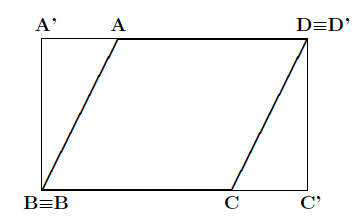
You can also change the explored range in the selected plane (relative to that identified by the three original points A, B and C) by use of the keyword MARGINS, as shown below:
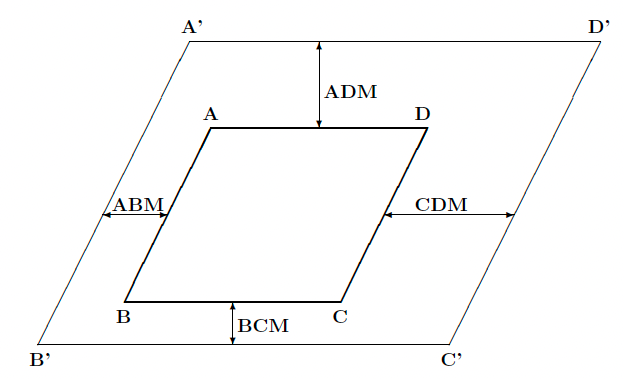
Input examples can be found at this tutorial page.
Hope this helps,
-
-
Charge State Calculation for periodic System in CRYSTAL17Hi,
To run a calculation with a not neutral unit cell, you must insert the keyword CHARGED at the end of the basis set input block, as in:
Title [geometry] END [basis set] CHARGED END [SCF parameters] ENDHope this helps,
-
Conversion of fort.25 file to .cube (Vesta file)Hi,
You can compute the electron density on a 3D grid of points and obtain data directly saved in a .cube format by use of the ECH3 keyword of the PROPERTIES module. If your system is 3D, all you have to do is insert something like:
ECH3 100 ENDin your .d3 PROPERTIES input file, where 100 is the number of points in the grid along the first axis. For a cubic system, this would produce a 100x100x100 grid.
Hope this helps,
-
Is there a software to create DOS/BAND input?Hi,
I haven't used it in a while but I remember XCrySDen had a GUI for k path selection.
What I typically do instead is use the Bilbao Crystallographic Server as a guide. If you navigate to "Space-group Symmetry" and then to "KVEC: The k-vector types and Brillouin zones of Space Groups", you will be able to select your space group of interest and then click on "Comparative listing of k-vector types".
For instance, for your P-1 space group you get:
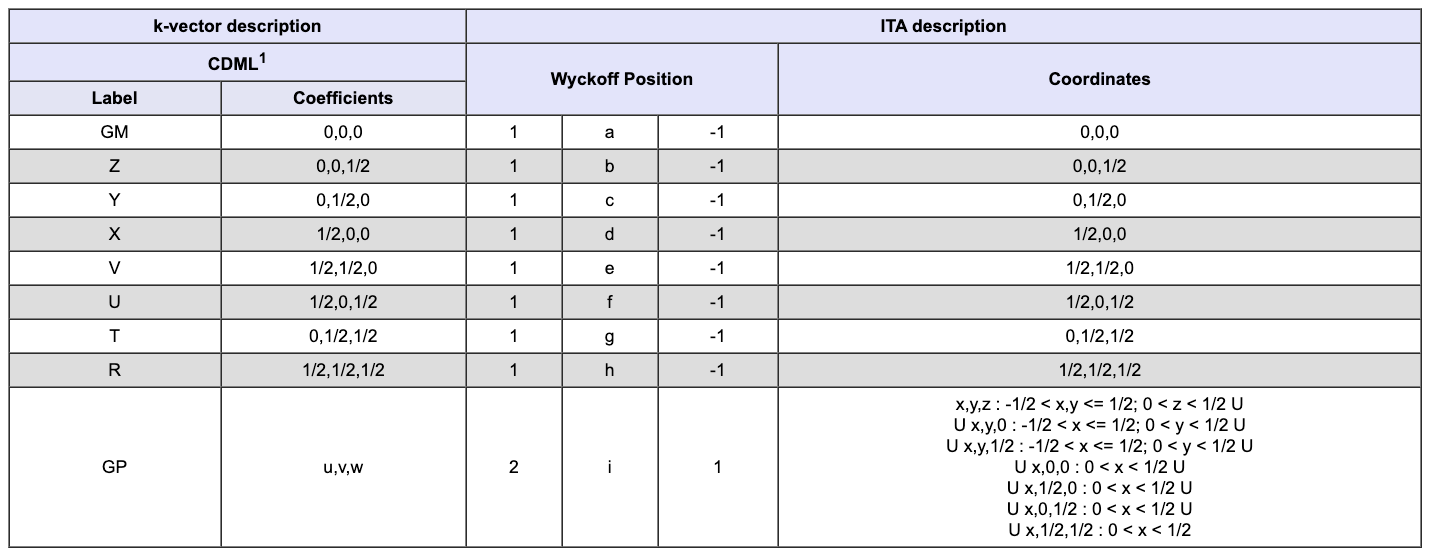
where you can find the coordinates of the high symmetry special points listed in the table (NOTE: if your space group admits a crystallographic cell that differs from the primitive cell, you will find both sets of coordinates in the table. Make sure you use the primitive ones to write the BAND input in the .d3 file) and also inspect the Brillouin zone:
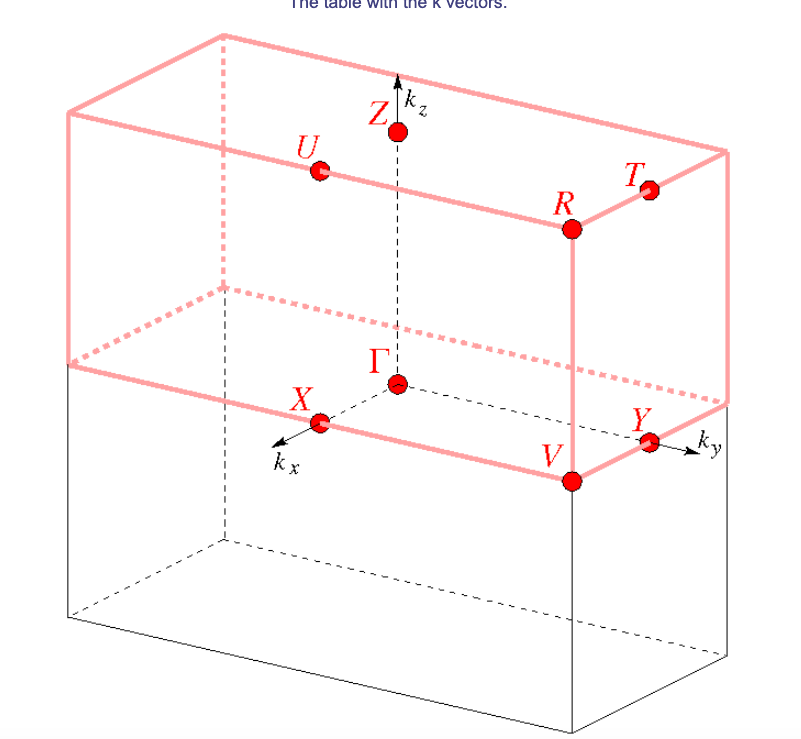
The order at which you explore these points does not really matter (unless you want to reproduce a specific path from some reference plot), as long as you explore most/all of them.
Hope this helps,
-
Negative value in the SCF of an anion vacancyHi,
Would you please share your full input file?
